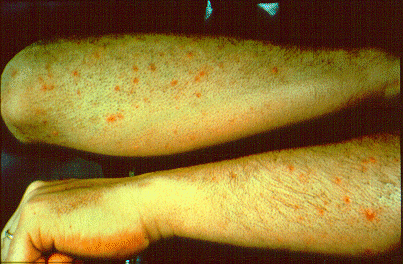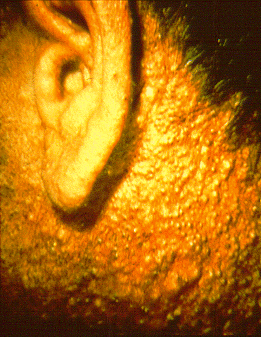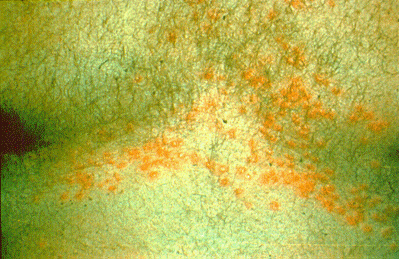Occupational Dermatoses
NOTE: This page is archived for historical purposes and is no longer being maintained or updated.
Slides 21 to 25
Slide 21 - Occupational Acne. Acute, Oil Folliculitis

Occupational acne is most commonly seen in workers exposed to insoluble cutting oils in the machine tool trades or in mechanics exposed to grease and lubricating oils. This worker developed folliculitis, sometimes called oil boils or acne, with multiple comedones and pustules on his arms and other covered areas of his body as a result of prolonged contact with oil. The lesions almost never develop from bacteria present in the oils.
Slide 22 - Oil Folliculitis Chronic, Chloracne

Chlordane is an extremely refractory type of acne caused by certain halogenated aromatic chemicals and can be certain halogogenated aromatic chemicals and can be accompaned by systemic toxicity. It represents one of the most sensitive indicators of biologic response to these chemicals. Chloracne in this herbicide production worker involved almost every follicular orifice on his face and neck with comedones, papules and cystlike lesions.
Slide 23 - Depigmentation

The hands of this hospital maintenance worker are depigmented form contact with a phenolic germicidal detergent. Irritation or sensitization to the chemical is not a prerequisite for the pigment loss to occur. This loss of pigment may be permanent.
Slide 24 - Granuloma

Granulomas represent a focal, chronic inflammatory reaction. These granulomas were produced by beryllium and are considered to be on a allergic basis. Non-allergic granulomas are more common and represent the skin's response to inoculated or implanted foreign materials such as wooden splinters, plant spines and silica.
Slide 25 - Eccrine

Miliaria represents blockage of the eccrine sweat ducts and may occur in workers who perspire excessively. In this case of miliaria rubra of prickly heat, the blockage site is the granular cell layer of the epidermis. When more than 30% of the skin surface is affected, an individual may develop thermoregulatory disorders such as heat exhaustion.
- Page last reviewed: January 5, 1998 (archived document)
- Content source:
- National Institute for Occupational Safety and Health Health Effects Laboratory Division (HELD)


 ShareCompartir
ShareCompartir